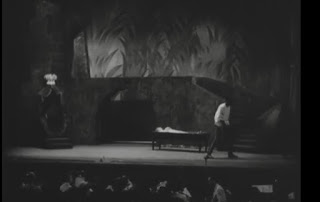Music Contest Poster, Estelle Levine, Artist, Federal Art Project, Library of Congress
Over the course of just a few golden years, from about 1935 to 1939, in New York City, the work of those artists was visible everywhere, from the theater marquees advertising a production to posters displayed on the streets.
 |
| One of a series of posters that were part of the New York Mayor's "Poster Project Emergency Relief Bureau," 1936, a Federal Art Project. |
 |
| Power at the Ritz (now the Walter Kerr Theater) |
Actors, directors, costume designers, playwrights and scene designers found a temporary home in New York theaters that produced productions sponsored by the Federal Theatre Project (FTP). A total of 15,000 people were employed by the FTP, and roughly 1,200 productions across the country were staged (radio productions were also supported by the project).
FTP director, Hallie Flanagan (Davis) hailed the project, proclaiming: "For the first time in the relief experiments of this country the preservation of the skill of the worker, and hence the preservation of his (sic) self-respect, became important."
The FTP folded in 1939. (The U.S. House Un-American Committee accused its practitioners of what else? being red.)
 |
| Burt Lancaster, pictured with Nick Cravat, performed in a circus as a part of the Federal Theatre Project |
African American performers were supported in a separate section of the FTP, known as the "Negro Unit." NYC's unit was one of the country's most popular and successful, staging roughly 30 productions.
In its first year, in 1935, two white directors, Orson Welles and John Houseman, served as the unit's directors. A "Voodoo" Macbeth, set in the Caribbean, was staged by Welles in 1936 at the Lafayette Theatre in Harlem. The production later went on tour. (See below for a film clip of the production.)
 |
A preview performance of Welles' Macbeth, offered free of charge, drew 3,000 more people than the New York theatre could accommodate |
 |
| Art for the Masses |
In 1935, the Federal Art Gallery opened at 7 East 38th Street, a gallery that was part of the Federal Art Project under the Works Progress
Administration. (In 1937, the gallery moved to 225 West
57th Street.) During its years of operation, it mounted roughly 40 exhibits including photography and children's art exhibits. Summer art classes were also offered free of charge throughout the city.
Critics
could be harsh (what's new?), and some derided the art project as a
mere catch-all; not all of the art exhibited was "high art," they argued. But
there can be no question that
the project supported artists and encouraged the idea that art was
essential to a healthy society. And, to be sure, the project supported
the work of numerous artists, including some of the most famous artists
of the 20th century, such as Berenice Abbott, Jackson Pollock, and Willem DeKooning. Abbott's "Changing New York" series, which constitutes one of the most valuable photo-histories of the American scene, was supported by the Federal Art Project.
Changing New York: Abbott's Blossom Restaurant, 103 Bowery, 1935, NYPL
New Yorkers were also treated to musical performances and concerts through the Federal Music Project. At the Theatre of Music, at 254 West 54th Street (later home to Studio 54), concerts were performed for "popular prices."
Music Concerts took place all over the city--not just in concert halls.
A New York Classic about Classic New York: Produced at the Height of the Great Depression
So let's just recap: hard economic times, federal projects to support artists, a public that is educated, inspired, and entertained, artists that flourish and produce invaluable works for their own and future generations, and on top of all that, Burt Lancaster in his early circus performing years! ....what's not to like?
~Jenny Thompson
Watch this 1937 film here, "We Work Again," produced by the Works Progress Administration. Included in the film are clips from Welles' MacBeth (11.11). -------------------------------------- * In 1939, the WPA name was changed to Works Projects Administration. |








No comments:
Post a Comment